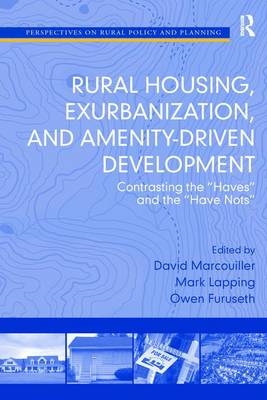
Rural Housing, Exurbanization, and Amenity-Driven Development
Routledge (Verlag)
978-1-138-27632-1 (ISBN)
Rural America is progressing through a dramatic and sustained post-industrial economic transition. For many, traditional means of household sustenance gained through agriculture, mining and rustic tourism are giving way to large scale corporate agriculture, footloose and globally competitive manufacturing firms, and mass tourism on an unprecedented scale. These changes have brought about an increased presence of affluent amenity migrants and returnees, as well as growing reliance on low-wage, seasonal jobs to sustain rural household incomes. This book argues that the character of rural housing reflects this transition and examines this using contemporary concepts of exurbanization, rural amenity-based development, and comparative distributional descriptions of the "haves" and the "have nots". Despite rapid in-migration and dramatic changes in land use, there remains a strong tendency for communities in rural America to maintain the idyllic small-town myth of large-lot, single-family home-ownership. This neglects to take into account the growing need for affordable housing (both owner-occupied and rental properties) for local residents and seasonal workers. This book suggests that greater emphasis be placed in rural housing policies that account for this rapid social and economic change and the need for affordable rural housing alternatives.
David Marcouiller is Professor of Urban and Regional Planning at the University of Wisconsin-Madison, USA, Mark Lapping is Distinguished Professor of the Muskie School of Public Policy and Management Planning at the University of Southern Maine, USA, and Owen Furuseth is Associate Provost for Metropolitan Studies and Academic Programs at the University of North Carolina, USA
I: The Context of Twenty-first Century Rural Housing; Chapter 1: An Introduction; Chapter 2: The Nature of Rural Housing; Chapter 3: The Exurbanization Process and Rural Housing Markets; Chapter 4: Heterogeneity of Rural Housing Markets; Chapter 5: Elderly Populations and the Rural Housing Continuum; II: Rural Amenity-Driven Housing: The “Haves”; Chapter 6: Natural Resources and Exurban Housing: Landscapes in Transition; Chapter 7: Housing Tourists: Accommodating Short-term Visitors; Chapter 8: The Rural Rich and Their Housing: Spatially Addressing the “Haves”; III: The Rural Housing “Have Nots”; Chapter 9: Chronic Poverty, Community Decline, and Amenity-Rich Growth in Rural America; Chapter 10: Exurbanization, Homeownership, and the Working Poor; Chapter 11: The Challenge of Housing California's Hired Farm Laborers; Chapter 12: Subprime Lending and Foreclosure in Rural Minnesota; Chapter 13: Homelessness in Rural America; IV: Policies to Affect Change in Rural Housing; Chapter 14: The Role of Nonprofit Organizations in Affecting Rural Housing Change; Chapter 15: Rarely Managing Growth: The Under-utilization of Land Use Policy Approaches; Chapter 16: Conclusions and Integrative Thoughts on Rural Housing Policy
| Erscheinungsdatum | 15.02.2017 |
|---|---|
| Verlagsort | London |
| Sprache | englisch |
| Maße | 156 x 234 mm |
| Gewicht | 453 g |
| Themenwelt | Naturwissenschaften ► Biologie ► Ökologie / Naturschutz |
| Naturwissenschaften ► Geowissenschaften ► Geografie / Kartografie | |
| Sozialwissenschaften ► Politik / Verwaltung ► Staat / Verwaltung | |
| Sozialwissenschaften ► Soziologie ► Spezielle Soziologien | |
| Wirtschaft ► Betriebswirtschaft / Management ► Rechnungswesen / Bilanzen | |
| Betriebswirtschaft / Management ► Spezielle Betriebswirtschaftslehre ► Immobilienwirtschaft | |
| ISBN-10 | 1-138-27632-4 / 1138276324 |
| ISBN-13 | 978-1-138-27632-1 / 9781138276321 |
| Zustand | Neuware |
| Haben Sie eine Frage zum Produkt? |
aus dem Bereich


